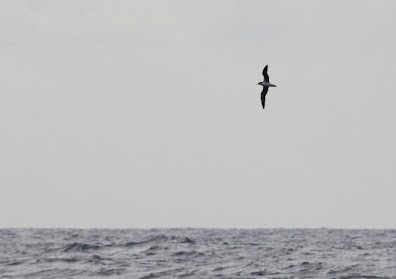The following is a brief report on our sightings of birds during our five and a bit days on Madeira last week. For some notes on our itinerary, check out the first post by scrolling down. I will follow this blog up with some of the more notable wildlife sightings...
Birds
Teal, Anas crecca
A female (or Green-winged Teal, A. carolinensis, seen at Machico)
Red-legged Partridge, Alectoris rufa
A couple of coveys seen on the approach to Pico Do Arieiro and also heard calling at Caso Do Sardinhia.
Trocaz Pigeon, Columba trocaz
Several seen in the Palheiro Gardens, Funchal, with a few seen in the mountains in various places, often sitting on telephone cables. More unusually, one was just above the coast at Canico.
Collared Dove, Streptopelia decaocto
A few seen around villages.
Plain Swift, Apus unicolor
Very common everywhere. A regular 'screaming party' of about 16 seen most evenings by the coast at Canico.
Pallid Swift, Apus pallidus
A small group seen and a few individuals at Caso Do Sardinhia.
Moorhen, Gallinula chloropus
A few seen by the rivers and in the small wetland at Ribera Brava.
Common Coot, Fulica atra
A pair on the wetland at Ribera Brava.
[Zino’s Petrel, Pterodroma madeira]
After seen many Desertas Petrels over the previous week, a Pterodroma seen from Porto Moniz seemed lighter in flight, more bouyant and with more frequent flapping - it could have been this species. Hard to put our fingers on why it felt different, a bit like the difference between Arctic and Common Tern at a distance. However, without closer views we couldn't rule out Desertas Petrel so it goes down as a possible.
Desertas Petrel, Pterodroma feae/deserta
Four seen from our balcony at Canico was brilliant, followed by up to 30 individuals seen on the Desertas Trip. Stunning birds, with a distinctive arcing flight, never seen to flap once! When feeding doing tight figure of eight turns. The chunky bill confirming this species was noticeable on closer birds, while the amount of white on the underwing never approached that supposedly shown by Zino's. There is some dispute as to whether the birds breeding on the Bugio in the Desertas are a separate species from Fea's Petrels breeding on the Canaries. I will leave that to the taxonomists, but either way, an absolutely spectacular taxon!
Great Shearwater, Ardenna gravis
One seen with five Desertas Petrels moving ahead of a squall on the way back to Funchal from the Desertas.
Cory’s Shearwater, Calonectris borealis
Abundant. Large numbers (several hundred) seen off Porto Moniz and along the south coast, indeed whenever we looked at the sea. Some spectacular feeding flocks, diving in from a height in the style of Gannets off Porto Moniz. Class birds.
Manx Shearwater, Puffinus puffinus
c50 seen off Porto Moniz on Tuesday, with c30 seen on Thursday. Some of the more distant birds may have been the following species...
Little/Barolo/Boyd's/Audobon’s Shearwater, Puffinus iherminieri?
At least ten seen from Porto Moniz on Tuesday and a couple seen on Thursday. Undoubtedly distant individuals slipped through without a confident identification.
Bulwer’s Petrel, Bulweria bulwerii
Our first record was of a dead individual by the shops at Porto Cruz :-( Two superb birds flew past the boat on the way out to the Desertas, followed by a fully feathered chick in a nest hole on Deserta Grande. Another single seen from Porto Moniz on Thursday.
Grey Heron, Ardea cinerea
One at the river mouth at Manico.
Little Egret, Egretta garzetta
One in the Palhiero Gardens and three on the beaches at Caso Do Sardinhia.
Whimbrel, Numenius phaeopus
One at Caso Do Sardinhia.
Turnstone, Arenaria interpres
Several seen at the rivers at Ribera Brava and Manicho.
Arctic Skua, Stercorarius parasiticus
Three flew west past Porto Moniz on Tuesday, with one east there on Thursday.
Black-headed Gull, Chroicocephalus ridibundus
One west at Porto Moniz on Tuesday.
Lesser Black-backed Gull, Larus fuscus
Small numbers seen loafing about in Funchal Harbour.
Atlantic Yellow-legged Gull, Larus michahellis atlantis
Common around the coast, with c200 loafing on the jetties in Funchal Harbour. All presumably Atlantis.
Roseate Tern, Sterna dougallii
Two very white small terns that flew past Canico on Friday evening were thought to be this species.
Common Tern, Sterna hirundo
Several seen at Porto Moniz and one on the Desertas trip.
Common Buzzard, Buteo buteo
Fairly common around the island.
Common Kestrel, Falco tinnunculus
Very common throughout the island.
Rock Sparrow, Petronia petronia
Three seen at Caso Do Sardinhia.
Berthelot’s Pipit, Anthus berthelotii
Common and confiding in open habitats, eg at Pont Do Parho, Pico Do Arieiro, Caso Do Sardinhia.
Grey Wagtail, Motacilla cinerea
Common around the coast and along the rivers.
Chaffinch, Fringilla coelebs
The very distinctive form maderensis was common in woodland areas and in the parks.
Greenfinch, Chloris chloris
A flock of 15 seen at Pont Do Pargo.
Atlantic Canary, Serinus canaria
Common throughout the island.
Blackcap, Sylvia atricapilla
Common throughout the island in suitable habitat.
Spectacled Warbler, Sylvia conspicillata
Two or three showed well in scrub near the car park at Pico Do Arieiro. These pics are of a couple of juveniles that were very inquisitive. Note the small stature compared to Whitethroat, very short primary projection and huge rufous wing panel.
Madeiran Firecrest, Regulus madeiriensis
Probably the most abundant bird in the forest, often very confiding.
Robin, Erithacus rubecula
Fairly common in wooded areas.
Northern Wheatear, Oenanthe oenanthe
One on the approach to Pico Do Arieiro and two seen at Caso Do Sardinhia.
Blackbird, Turdus merula
Small numbers around Canico and in wooded/garden areas throughout the island.


































































